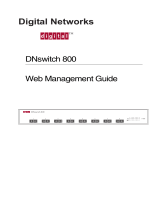
Contents
OmniSwitch AOS Release 6 Switch Management Guide September 2009 vii
Copying the Working Directory to the Certified Directory ...................................5-20
Copying the Certified Directory to the Working Directory ...................................5-21
Show Currently Used Configuration ......................................................................5-22
Show Switch Files ..................................................................................................5-23
Managing Redundancy in a Stack and CMM ...............................................................5-24
Rebooting the Switch .............................................................................................5-24
Copying the Working Directory to the Certified Directory ...................................5-25
Synchronizing the Primary and Secondary CMMs ................................................5-26
CMM Switching Fabric ..........................................................................................5-27
Swapping the Primary CMM for the Secondary CMM .........................................5-28
Show Currently Used Configuration ......................................................................5-29
Emergency Restore of the boot.cfg File ........................................................................5-30
Can I Restore the boot.file While Running from Certified? ..................................5-30
Displaying CMM Conditions ........................................................................................5-31
Chapter 6 Using the CLI ...............................................................................................................6-1
CLI Specifications ...........................................................................................................6-2
CLI Overview ..................................................................................................................6-2
Online Configuration ................................................................................................6-2
Offline Configuration Using Configuration Files ....................................................6-3
Command Entry Rules and Syntax .................................................................................6-3
Text Conventions .....................................................................................................6-3
Using “Show” Commands .......................................................................................6-4
Using the “No” Form ...............................................................................................6-4
Using “Alias” Commands ........................................................................................6-4
Partial Keyword Completion ....................................................................................6-5
Command Help ...............................................................................................................6-5
Tutorial for Building a Command Using Help .........................................................6-7
CLI Services ....................................................................................................................6-9
Command Line Editing ............................................................................................6-9
Deleting Characters ...........................................................................................6-9
Recalling the Previous Command Line ...........................................................6-10
Inserting Characters .........................................................................................6-10
Syntax Checking ....................................................................................................6-11
Prefix Recognition ..................................................................................................6-11
Example for Using Prefix Recognition ...........................................................6-12
Prefix Prompt ...................................................................................................6-13
Command History ..................................................................................................6-13
Logging CLI Commands and Entry Results .................................................................6-15
Enabling Command Logging ..........................................................................6-15
Disabling Command Logging .........................................................................6-15
Viewing the Current Command Logging Status .............................................6-16
Viewing Logged CLI Commands and Command Entry Results ....................6-16
Customizing the Screen Display ...................................................................................6-17
Changing the Screen Size .......................................................................................6-17
Changing the CLI Prompt ......................................................................................6-17
Displaying Table Information ................................................................................6-18




















